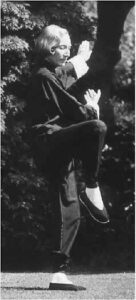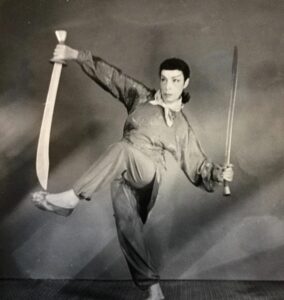

Dance, Psychotherapy and Tai Chi may seem worlds apart at first, but they have some important aspects in common. They have all been an integral part of my life for many years and I find so much synergy between them that each informs the others in my practice.
Tai Chi is more than a Chinese internal martial art for me – I have long felt it’s synergy with dance and embodied psychotherapy. Its health benefits to our body, mind, and spirits are becoming more widely understood and adopted in Western culture thanks to medical professionals and clinical practitioners who have the vision and insight to combine their professional skills with their passion for this ancient practice.
People often wonder why, as a psychotherapist, my wellbeing practice, Movement In Mind, focusses on Tai Chi and Qi Gong. The explanation is simple – the mind body connection. Our focus is as much on mental health as physical wellbeing. In other words, body awareness and it’s relevance to feelings and emotions underpin all aspects of our work. Tai Chi is an internally focussed movement modality. Dance Movement Psychotherapy (DMP) is an embodied psychotherapeutic intervention based on the inter-relationship between psyche, soma, and spirit. They are separate disciplines. However they have many therapeutic aspects in common. Both focus on the movement and sensations of the body. This brings the awareness to the present moment. Using the senses in this way helps to ground the emotions. Listening with the whole body and mind, allows the psyche and soma to communicate through the language of sensation.
Early pioneers recognised the healing potential
I was, therefore, fascinated to learn that the two earliest pioneers of Tai Chi in the west were dancers. Furthermore, one of them was also a psychotherapist who was developing an embodied approach to mental therapy. These forgotten pioneers, Sophia Delza and Gerda Geddes, were fascinating women who first introduced the art to the western world in the 50’s. Coincidentally, this was the same time as Dance Movement Therapy was beginning to emerge in the United States.
As dancers, both Delza and Geddes embraced Tai Chi as an alternative and holistic approach to dance and movement. In time, Delza would promote the art from a health perspective, while Geddes would embrace its’ spiritual aspects. Both were aware that they were practicing what was essentially a martial art, although fighting was never their goal. Both had trained in modern dance, and both trained with renowned masters in Shanghai in the late 1940’s. Geddes was developing an idea to merge her studies in dance and psychotherapy to create a physically-oriented therapeutic model. As she watched an elderly man perform the slow, meditative movements of Tai Chi in an open field at dawn, Geddes realized the Chinese had in fact been cultivating one for centuries.
Use in therapy today
The modern appeal of Tai Chi’s role in wellbeing is fascinating to consider as Delza and Geddes both envisioned Tai Chi’s relevance and potential health benefits more than a half century ago. Although they had a wellbeing vision for this ancient art in the modern world, the kung fu craze was in full swing at the time. Consequently, the mind and body health culture envisioned by the two pioneers took a quiet back seat. However, they sowed the seeds for Tai Chi in the west. Their students (and their student’s students) now teach in countries around the world and its health benefits are increasingly backed by clinical studies.
An article in the Guardian commented on the transformative aspects of mind body practices such as Tai Chi and Qi Gong. It concluded that these types of approaches help people reconnect and become more in tune with their bodies or support better management of emotions. DMP is also a transformative process. One of its key elements is embodied emotion.
Scientists have discovered that mind body practices can be useful in treating Post Traumatic Stress Disorder (PTSD). A 2013 meta-analysis in the Journal of Investigative Medicine showed that they are becoming more frequently used to treat the symptoms of the condition. This is because they have been shown to reduce anxiety, depression and anger. These practices can also increase self-esteem, energy, relaxation, and can provide a coping mechanism when a situation(s) get stressful.
The focus on the moving body and non-verbal phenomena means that Dance Movement Psychotherapy (DMP) is also an effective intervention for people experiencing mental or emotional distress. It can help process the impact of trauma or dealing with loss. In addition, it can assist with managing anxiety, depression and emotional/behavioural difficulties.
The mind body connection
According to Dr. Bessel Van Der Kolk, in The Body Keeps The Score, Charles Darwin wrote about body-brain connections as long ago as 1872. In The Expression of Emotions in Man and Animals, Darwin asserts that intense emotions involve the mind, gut, and heart. Until recently, the communication between mind and body has largely been overlooked by Western medicine. However, it has always been central to Traditional Chinese Medicine (TCM). Western science is just starting to understand it’s impact on trauma and recovery.
Mind-body exercises, such as Tai Chi and Qigong, can help by reducing, managing, and even possibly avoiding stress and anxiety. They strengthen the immune system, while having a positive impact on both the nervous system and mood regulating hormones. Dance Movement Psychotherapy offers embodied interventions that take into account the client’s lived experience and how they experience living in their body. This extends to their relationship to their body, as well as emotional responses that may be hard to put into words. At the heart of this is the intrinsic relationship between psyche, soma, and spirit.
The technical term for not being aware of what is going on inside your body is “alexithymia”. Being aware helps us to navigate through life safely and mindfully. Mind body practices increase self-awareness. This helps us to observe what is going on inside our bodies as we move, breathe, and go about our day. This awareness is a vital step in the journey towards healing from trauma. Awareness of the connection between mind and our body is important in order to appropriately act on the sensations we are feeling.
In practice
As a Movement Psychotherapist or Tai Chi teacher, I can’t ‘fix’ anyone or anything. If only I could. But I can’t help people in that way. What I can do instead is to help them by empowering them to help themselves.
Tai Chi and Qi Gong are gently therapeutic ways to get in touch with mind and body. Sometimes that’s enough. On the other hand, for more complex difficulties greater insight or emotional and cognitive shifts may be necessary. In that case these mind body practices can softly open the door to deeper therapy work and Movement Psychotherapy methodologies.
